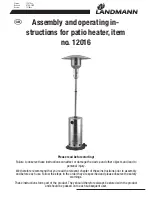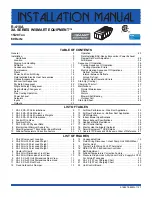
SPECTRUM INSTALLATION AND OPERATING INSTRUCTIONS
Page 5
WARNING: Failure to maintain minimum
clearances between vent connectors and any
combustible material can result in a fire causing
extensive property damage, severe personal
injury or death!
To determine the appropriate power venter for the boiler/
water heater, see Table 5, Power Venter Sizes. Follow
the power venter manufacturer’s installation instructions.
Table 5 - Power Venter Sizes
COMMON VENT SYSTEMS
If an existing boiler/water heater is removed from a
common venting system, the common venting system
may then be too large for the proper venting of the
remaining appliances connected to it. At the time of
removal of an existing boiler/water heater, the following
steps shall be followed with each appliance remaining
connected to the common venting system placed in
operation, while the other appliances remaining
connected to the common venting system are not in
operation.
Au moment du retrait d’une chaudière existante, les
mesures suivantes doivent être prises pour chaque
appareil toujours raccordé au système d’évacuation
commun et qui fonctionne alors que d’autres appareils
toujours raccordés au système d’évacuation ne fonction-
nent pas: système d’évacuation.
a) Seal any unused openings in the common venting
system.
Sceller toutes les ouvertures non utilisées du sys-tème
d’évacuation.
b) Visually inspect the venting system for proper size
and horizontal pitch and determine there is no block-
age or restriction, leakage, corrosion and other defi-
ciencies which could cause an unsafe condition.
Inspecter de façon visuelle le système d’évacuation
pour déterminer la grosser et l’inclinaison horizontale
qui conviennent et s’assurer que le système est ex-
empt d’obstruction, d’étranglement de fruite, de cor-
rosion et autres défaillances qui pourraient présenter
des risques.
Chimney Inspection & Sizing
A thorough inspection of the masonry chimney must be
performed to ensure that the chimney is clean, properly
constructed, lined and sized. Exterior masonry chimneys
should not be used unless properly lined to prevent
condensation and draft problems. Table 4 lists the
equivalent breeching and flue sizes required for the
boiler/water heater.
Table 4 - Equivalent Breeching & Chimney Size
Model Size Size
Size
in
mm
100
5
127
150
6
152
200
7
178
250
8
203
300
8
203
350
9
229
400
10
254
Note: These sizes are based on a
20 ft
,
6.1 m
chimney height.
When more than one appliance is connected to the
same chimney flue, the flue must be large enough to
safely vent the combined output of all the appliances.
WARNING: If an appliance using any type of a
mechanical draft system operating under
positive pressure is connected to a chimney flue,
never connect any other appliances to this flue.
Doing so can result in the accumulation of
carbon monoxide which can cause severe
personal injury or death!
Vent Connections
Always use a type B or single wall galvanized metal vent
pipe the same diameter as the draft hood flue collar,
Table 4. Use the shortest, straightest vent system
possible for the installation. If horizontal runs exceed
6 ft
,
1.8 m they must be supported at
6 ft
,
1.8 m
intervals with overhead hangers. The vent system should
be sloped up toward the chimney at a minimum rate of
1/4 in/ft
,
20 mm/m and terminate flush with the inside
of the chimney flue. Fasten each connection with at least
3 corrosion resistant sheet metal screws.
WARNING: Never modify or alter any part of the
boiler’s draft hood. This includes the removal or
alteration of any baffles. Never install a vent pipe
of a diameter different than that of the boiler
draft hood flue collar. Failure to comply with this
warning can result in severe personal injury or
death!
Always provide a minimum clearance of
6 in
,
152 mm
between type C vent pipe and any combustible
materials. Type B1 vent may be used, clearance
between it and any combustible material must be as
listed.
Spectrum Power Venter
Max. Pipe Length
Model
Size
FT
m
100-250
HS-1
100
31
300-400
HS-2
100
31






































